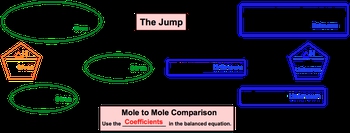Stoichiometry is essential for understanding the numerical relationships between reactants and products in a balanced chemical equation. When we introduce thermochemical equations, we incorporate the concept of enthalpy change, denoted as ΔHrxn, which represents the heat absorbed or released during a chemical reaction. This is crucial for analyzing how energy changes in conjunction with the reaction.
In thermochemical equations, a stoichiometric chart is utilized to relate the known quantity of one compound to the unknown quantity of another. This chart is paired with a balanced chemical equation, where the ΔHrxn is indicated alongside the reaction. The primary goal is to establish a connection between the enthalpy change and various quantities such as moles, grams, or molecules of the substances involved.
Unlike traditional stoichiometry, which often focuses on mole-to-mole comparisons, thermochemical equations emphasize the relationship between ΔH and the number of moles. This distinction is vital for accurately calculating energy changes in reactions. Understanding this relationship allows for a deeper insight into the thermodynamics of chemical processes, enabling predictions about energy transfer and reaction feasibility.


